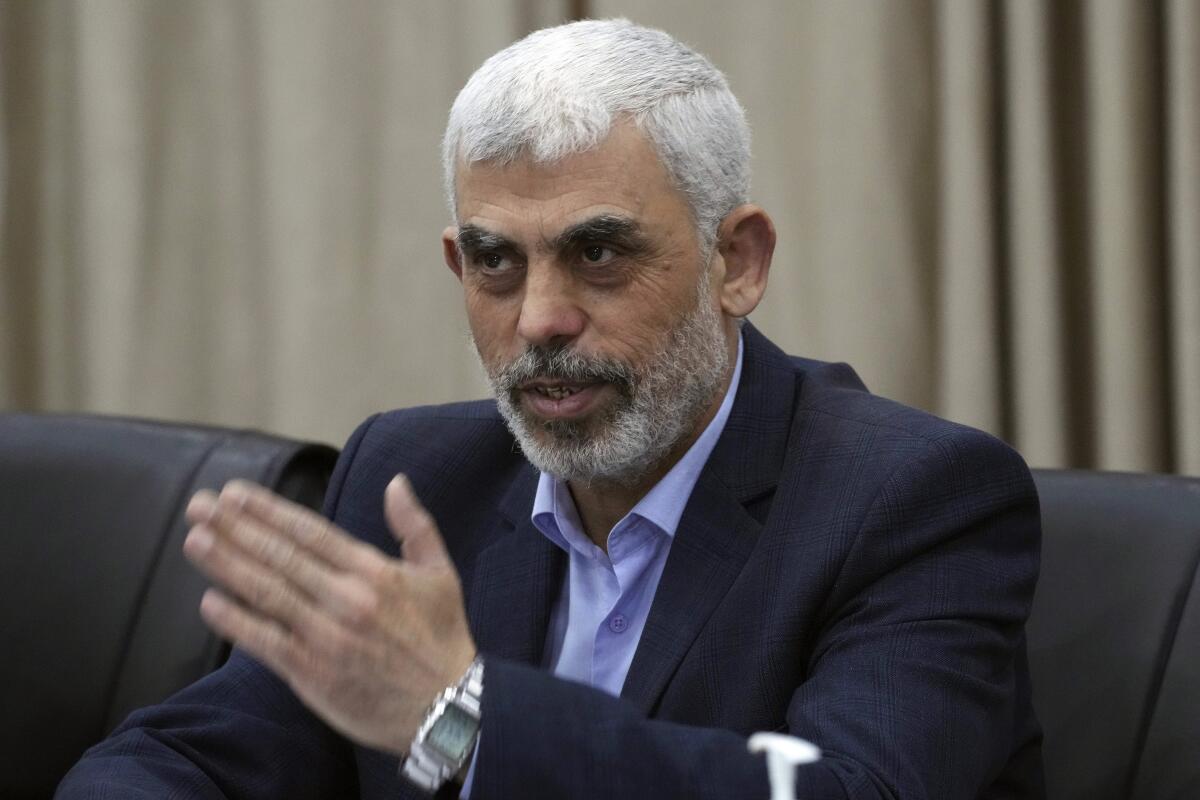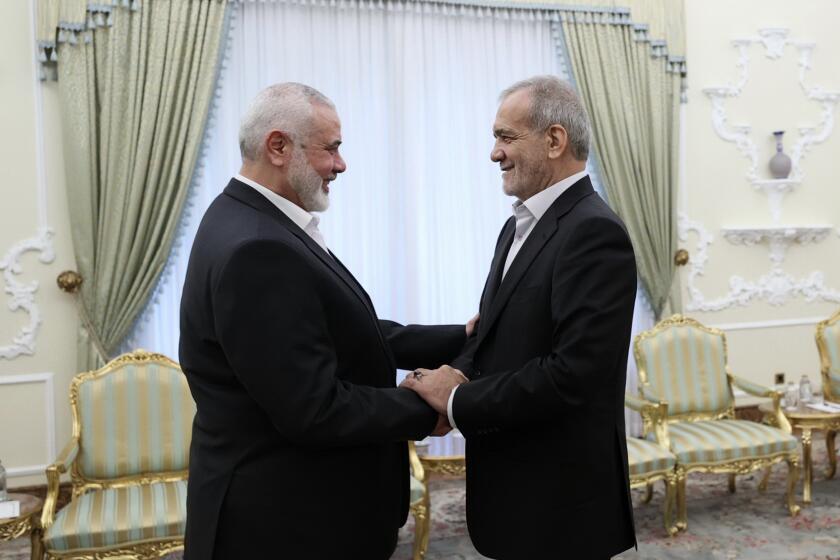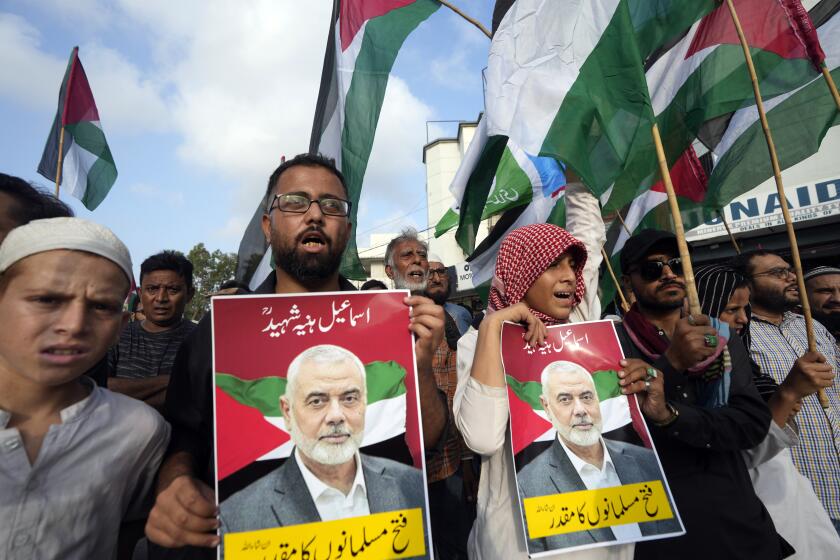Hamas has a new leader. How will that affect the war in Gaza and cease-fire efforts?

Yahya Sinwar’s appointment as the top leader of Hamas formalizes a role he assumed in the early hours of Oct. 7, when the surprise attack into Israel that he helped mastermind ushered in the bloodiest chapter of the Israeli-Palestinian conflict.
He is seen as a hard-liner with closer ties to Hamas’ armed wing than his predecessor, Ismail Haniyeh, who was killed in an explosion in Iran’s capital last month that was widely blamed on Israel and could spark an all-out regional war.
Sinwar was already seen as having the final word on any cease-fire agreement for Gaza and the release of dozens of Israeli hostages still held by Hamas.
But he is deep in hiding inside Gaza, and mediators say it takes several days to exchange messages with him. That raises questions about how he would manage a sprawling organization with cadres across the Middle East.
Hamas has survived the killing of several top leaders across more than three decades, while maintaining a high degree of internal cohesion — and tapping Sinwar, who tops Israel’s most-wanted list, was a show of defiance.
But Hamas has never faced a crisis of this magnitude — and the man who engineered it is now charged with managing the fallout.
Hamas leader Ismail Haniyeh was assassinated in Iran after attending the inauguration of the country’s new president, Iran and the militant group said early Wednesday. Hamas blamed an Israeli airstrike.
An even tougher stance toward Israel
Haniyeh was a veteran of Hamas’ political wing who had once served as Palestinian Authority prime minister and in more recent years had managed the group’s affairs from his base in Qatar.
While Hamas has always championed armed struggle, Haniyeh and other exiled leaders had occasionally struck a more moderate tone, even expressing openness to a possible two-state solution, although still officially refusing to recognize Israel.
Sinwar, by contrast, spent more than two decades in Israeli prisons and told interrogators he had killed 12 suspected Palestinian collaborators, gaining a reputation for brutality among people on both sides of the conflict.
Hamas political leader Ismail Haniyeh was a key figure in negotiations to end Israel-Hamas war. How will the U.S. react?
He and Mohammed Deif, the shadowy head of Hamas’ armed wing who Israel claims to have killed in a recent strike, spent years building up the group’s military strength and are believed to have devised the Oct. 7 attack. Militants burst into Israel that day, killing some 1,200 people and abducting around 250.
In recent negotiations, “Haniyeh had played a big role in trying to convince Sinwar to accept a cease-fire proposal with Israel,’’ said Hugh Lovatt, an expert on the Israeli-Palestinian conflict at the European Council on Foreign Relations.
Sinwar has stuck to demands for the release of hundreds of Palestinian prisoners, the full withdrawal of Israeli forces from Gaza and a lasting cease-fire — even as nearly 40,000 Palestinians have been killed in the Israel-Hamas war, according to Gaza’s Health Ministry, which does not differentiate between civilians and combatants in its count.
Israeli Prime Minister Benjamin Netanyahu has vowed to continue the war until Hamas is completely destroyed and all the hostages return home.
“The killing of Haniyeh already brought negotiations back to the drawing board,” said Lina Khatib, an expert on the conflict at Chatham House, a London-based think tank. “This next chess move by Hamas makes negotiations even trickier.”
Sadeq Abu Amer, head of the Palestinian Dialogue Group, a think tank based in Turkey, said that though Sinwar’s elevation might appear to be a “challenge to Israel,” it is still possible to make a deal.
He added that Sinwar, in his new role, “might take a step that will surprise everyone.”
Leading from the shadows
Predicting how Sinwar will lead Hamas is difficult because of the secrecy around him.
Sinwar has not been seen since the start of the war and even before Oct. 7 made only rare public appearances. He is probably in hiding deep inside Hamas’ tunnel network and largely cut off from the outside world.
While he can be expected to set overall policy and make the final decision on any cease-fire deal, Hamas’ day-to-day operations in the Israeli-occupied West Bank and elsewhere are likely to be managed by its exiled leaders in Qatar, Lebanon, Turkey and Iran.
“There are issues that he can make a decision on and there are issues and matters that his deputies and the rest of the members of the political bureau can do,” said Hani al Masri, a veteran Palestinian analyst who has met most of Hamas’ leaders over the years, including Haniyeh and Sinwar.
Hamas has a long history of persevering after the killing of its top leaders — including its founder and spiritual leader, Sheikh Ahmed Yassin, who was killed in an airstrike in 2004.
But it has never faced a campaign of targeted killings on this scale.
Israel says it has killed scores of Hamas commanders in Gaza, including Deif, whose death Hamas has neither confirmed nor denied. Another top Hamas leader, Saleh Arouri, was killed in an apparent Israeli airstrike in Beirut in January. The string of targeted killings has probably led other Hamas leaders to limit their movements and contacts.
That could eventually degrade the organization, even as it enjoys the support of many — but not most — Palestinians.
“Israel’s elimination of senior Hamas leaders who cannot easily be replaced has likely had a qualitative impact on the movement,” Lovatt said. “More fundamentally, though, the killing of senior figures such as Arouri and Haniyeh appears to have tipped the movement in a more hard-line direction.”
Krauss writes for the Associated Press. AP writers Jack Jeffery in Ramallah, West Bank, and Kareem Chehayeb, Sarah El Deeb and Abby Sewell in Beirut contributed to this report.
More to Read
Sign up for Essential California
The most important California stories and recommendations in your inbox every morning.
You may occasionally receive promotional content from the Los Angeles Times.












